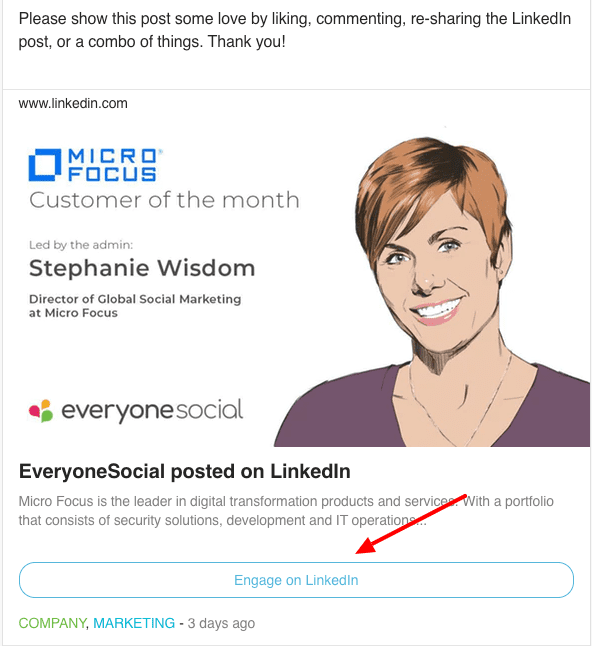By now, if you are familiar with our content on EveryoneSocial, you’ll know we are a big proponent of activating employees on behalf of their organizations.
Meaning, the people at your company should help be the voice of the brand. They should be creating and sharing about their experiences, showcasing their expertise, and their general thoughts via social media.
Employee activation in mind, we have been developing our product for over 8 years with the ultimate goal to keep employees informed, creating, and sharing — wherever they are working.
Let’s be real though, not every employee is a social media or content expert — but that doesn’t mean they do not have important things to say or share.
Below are the social media posts your company should encourage employees to create and share to their networks.
Note: The easiest way to organize and get your employees involved is to build a strategy and implement an employee advocacy platform like EveryoneSocial. It will make engaging your workforce a breeze, keep employees engaged quickly, and help your company measure ROI.
Sharing
At the core of an employee advocacy strategy and platform is enabling employees to access and share content to their social media accounts. It’s not something that should be forced on people, but encouraged rather.
The impact is two-fold, as it helps employees grow their networks, can generate new professional opportunities, helps them become more informed, and helps them become thought leaders.
And for the organization, you have storytellers helping to humanize the brand and as a result of putting a human face to the brand name: reaching untapped audiences where many are unfamiliar with your company.
For example, one of our customers has activated almost 1,000 employees and they have a combined social reach of almost 800,000! That is 3x the size of their company profile following on LinkedIn and Twitter added together.
The calculus is simple: people engage with people, not the abstraction of a brand name, but companies are made of storytelling humans — so activating people within companies is the solution!
So what social media posts will engage employees such that they will deem it worthy to share with their own networks?
Behind the Scenes
One of the best social media posts people love to engage with is what others are working on and their work environments. An inside glimpse to how employees are working, their department, and the type of space they are in everyday.
One of our employees shared a post of his baby daughter “intern” helping at the home office. Perhaps unsurprising, that post (and past posts like it) received upwards of 1000x more engagement than officially branded content.
I’m not suggesting you blast your networks with cuteness, but behind the scenes content that is clearly authored by a real person is very relatable.
A look behind the scenes allows different audiences to get to know your company, builds more trust, and exposes a human element to your company.
Introducing New Employees
A great way to welcome new employees to the company is to show excitement and share content out about the new faces of the brand. This could be a simple picture and copy or a video about the new person joining the company.
People love to see the faces of the brand that are making the organization run and that your team rallies around them with a warm welcome.
If you want people to support your brand on social, take these simple first steps and support your own cohort on social 😊
Company Content
Of course, you can’t ignore company content either!
But you want to make sure the content mix is varied, nothing says “Blah” more than generic 500 word articles that add little value. Employees won’t want to share it and the content really adds no value to our working routines or our personal lives.
So if your content marketing is weak, a first step is fixing that with a content strategy.
But these social media posts will include blog articles, guides, podcasts, videos, press releases, company milestones, and more. This content is always valuable, just ensure it’s top quality so your employees won’t ignore it.
Sharing Customer Stories
Besides employees, audiences want to learn about the awesome achievements and results of your customers. Plus, employees love sharing about how their company is helping many awesome brands.
Give them powerful social media posts about customers, which will be more interesting for your team to share.
This could be case studies, interviews, pictures or videos, or third-party content where customers were interviewed or received accolades.
And these can help your marketing and sales teams as more people start to trust your product or services.
Specific Company Campaigns
Every company is different about how they approach social media and marketing.
But generally, there will probably be different company initiatives and campaigns that you want to get out to as many people as possible.
Things like company events, charity initiatives, contests, etc. These are all items that are worth having employees share to their networks.
Engaging Company Social Posts
Although employees can help be the voice of the brand online, your company should still have highly active social media branded accounts.
And a great way to extend the reach and engagement is to have employees re-share, comment, like, or engage in multiple ways with your own brand.
Not every employee follows your company pages or even sees the new posts in their feeds. A great way around this is to include the direct social links in your employee advocacy program.
That way you can ensure employees are notified, since it is in the company emails, and have it in their program timelines. An example of this is how we build it in EveryoneSocial, called “Engage.”

Creating
While you have someone leading the strategy and content within your employee advocacy or employee sharing process, it can’t all just be on the admins. Certainly, they are the owners of social content but everyone has the ability to create unique content as well.
User generated content continues to help humanize the brand, be more interesting and authentic to audiences, and employees are more interested in getting involved when they can share their insights or work.
Plus, co-workers will like giving kudos and sharing their fellow colleagues’ content.
92% of consumers trust online content from friends, colleagues, and family above all other forms of brand messages and social campaigns that incorporate UGC see a 50% lift in engagement (Salesforce).
So what types of content should employees outside of marketing consider creating?
Taking Pictures or Videos of work
Content creation and social media posts do not need to be fancy. Many times the personable and simple kinds of social posts connect the best with audiences.
An easy way to get employees involved and creating is through the use of pictures or video. This can be on work projects they are involved in, company outings, new events, work travel, work culture, etc.
When this content is added to an employee advocacy program, you now have all degrees of employees being able to engage, comment, tag teammates, and share it out to bring more awareness to the content.
The recognition and value others see in it, the more other employees will get involved and willing to share their images, videos, and thoughts.
Over 50% of people said they create content at least once daily, with 23% saying that they create more frequently — 2 to 5 times per day (Crowdtap).
Knowledge Posts for Others to Share
While sharing links and media is always a standard option, sometimes plain text with nuggets of information can add a lot of value on social media.
It breaks up the social timelines, and allows employees to use their voice and show their writing style.
Not everyone needs to be a novelist when it comes to their writing, but every employee has a skill or insights to share.
Third-Party Content
While creating and sharing content related to your company is important, you have to be careful that it’s not all just self-centered. Meaning, you need quality and relevant content for social media posts that is beyond your company blog or news.
If you are organizing your employee advocacy program in various groups, this is a good place to include trusted sources employees would enjoy.
And not only that, encourage employees to recommend articles they found valuable and that other colleagues can read or share.
I included this into the “creating” section because employees recommending and adding commentary to why they added the content is part of the curation process
Internal Posts Not for Sharing
While sharing content is the crux of a strong employee advocacy program, these social media posts are for internal consumption only.
Your company’s employees can still be social and part of the community, but maybe aren’t necessarily interested in sharing to social media networks.
However, these internal social posts still drive engagement, knowledge sharing, and empower others to be engaging with their colleagues content. Not all content is for social media, but anything created by employees is still part of the creation process.
How Do You Get Employees Sharing and Creating?
It’s a common question many organizations have if they are completely new to the idea of employee advocacy. And it can seem like a daunting task, but it’s a bit easier than you realize.
First, remember this stat:
98% of employees use at least one social media site for personal use, of which 50% are already posting about their company (Weber Shandwick).
Most of your company’s employees have social networks and half of them already share on behalf of the brand. This makes it much easier to begin and develop a successful employee advocacy program.
But here are some of the ways to get employees sharing and creating.
- Build positive company culture and prioritize employee experience
- Choosing the right employee advocacy vendor
- Show employees what it’s in it for them (the benefits to them beyond just the company)
- Provide social media training and basic learning sessions
- Onboard new hires from day one
- Get executive excitement and support
- Let employees participate in conversations
If you are looking for more tips on employee advocacy adoption, this post will be incredibly beneficial to you. It covers the above tips in more detail as well as other ways to get employees advocating for your company.
















